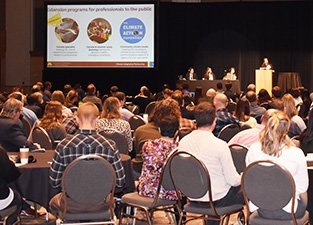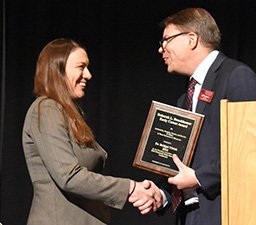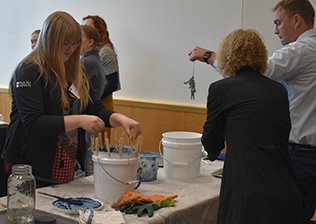
The 2022 Minnesota Water Resources Conference marked its in-person return to the St. Paul RiverCentre with an emphasis on the basics of water stewardship and care for the climate. A plenary panel presentation, Climate and Water – the Minnesota Climate Action Framework, addressing climate adaptation in Minnesota. The plenary panel members, Dana Vanderbosch, MPCA, Mindy Granley, Duluth Sustainability Officer, and Heidi Roop, Director of the Minnesota Climate Adaptation Partnership began by reminding their audience that 2022 is the 50th anniversary of the passage of the Clean Water Act. That law allowed the government power to regulate and enforce water quality standards across the US.
While large-scale programs are important to reducing greenhouse gases, the panelists promoted individual actions as key to climate action success. Vanderbosch spoke of “building climate smart communities” by providing funding for community green spaces, as trees reduce heat stands, drinking water protection and stormwater infrastructure. Measures of program progress would show 100% of communities with climate adaptation plans in place, increase in tree canopies, 30% by 2030 and 40% by 2050.
Mindy Granley provided local climate perspective in Duluth, which saw increased climate action after leaders signed on to the Climate Action Work Plan. The five-year blueprint focuses on short term action items for future projects to build upon. Resources are given to people who will act and benefit from their work. “Be clear and honest about who pays, and who benefit,” said Granley. “Start small, be calm and full of life, remember to reflect and listen.”
Heidi Roop explained MCAPs apparent focus on adaptation, “Prevention and preparation have lots of overlap,” and MCAP works on both levels, by providing resources and technical services, Extension education and people to help communities.
The building blocks of community climate readiness are motivation, capacity (resources and tools) and authority to enforce regulations. A current project underway is the Minnesota Climate Data Project, which provides historical climate data as well as projected future climate behavior and temperature changes, providing a roadmap for communities as they build their climate adaptation strategies.
Following Tuesday’s luncheon, the Dave Ford and the inaugural Deborah L. Swackhamer Early Career awards were presented. There were two recipients of the Dave Ford award this year, Rebecca Flood and Andrea Hendrickson. Flood was recognized for her mentorship of women throughout her 40-year career as an environmental regulator, as well as her work to decommission sub-performing wastewater treatment plants across Minnesota and creating the Metropolitan Council Environmental Services effective regional wastewater system.
Innovation in transportation hydraulics earned Hendrickson her Ford award, as she was the author of the standards and specifications of bridges, culverts and stormwater drain systems, during her tenure as State Hydraulics Engineer from 2004-2022. Hendrickson was also recognized as generous with her knowledge and mentorship of colleagues, many of whom have also gone on to do exemplary water resources work at MnDot.

Bridget Ulrich accepted the Deborah L. Swackhamer Early Career Award, noting that although she and Swackhamer were rarely in the same room, “She was one of my greatest role models.”Ulrich’s research focus mirrors that of her mentor, analyzing emerging contaminants such as poly-and perfluoroalkly substances (PFAS). Ulrich recalled a difficult time in her graduate school education when after a botched experiment she struggled to maintain her motivation to continue her career. She wrote an email to Swackhamer asking her advice. She received a lengthy, thoughtful response, telling her in part: “For the greatest impact, build a reputation for integrity; you can make a big difference.”
Another panel discussion was Wednesday morning’s plenary offering, looking to the past and future of the Minnesota Clean Water Fund – Creating the Legacy for Today and Tomorrow. Panel members were John Linc Stine, former head of MPCA, John Barton, CWC chair and Patty Ackerman, Minnesota House, leader of the Climate Action Caucus.

The Legacy fund amendment was on the 2008 Minnesota ballot, in the midst of a recession. A coalition of hunters and outdoor enthusiasts, artists, water professionals and state agencies provided enough voter appeal to pass the amendment with 56% of the vote. Taxpayers voted to raise their taxes to create a source of money dedicated to solving Minnesota water issues.
The CWF applied a systematic approach to allocation of amendment funds:
- Testing for water problems
- Develop strategy to address water problems
- Create to do list
- Stakeholders and other directly involved determine what gets done first
- All set for funding when it becomes available
Barton pointed to other values the CWF provides:
- Fulfillment of federal requirements for water quality standards
- More funding available to hire local expertise
- Enhanced water protection
- Big projects are shovel ready when federal funding money becomes available
The fund allows for long – term planning, escaping short term grant cycles by providing reliable funding. “We are more proactive rather than reactive, which is much more cost efficient,” said John Barton.
University of Minnesota’s Matt Simcik, professor, Division of Environmental Health Sciences, provided the final plenary of the conference on the topic of PFAS and the Implications for Minnesota’s Water Resources
Florine, a highly electromagnetic element used in non-stick surfactants like Teflon is one of the factors in the movement of PFASs in the water environment as “…florine gives compounds wings,” said Simcik. Floro chemicals are used in soaps and fire-fighting foam, stain and water- resistant sprays for upholstery and clothing all of which eventual wind up in surface and groundwaters. All these helpful products require the use of these “forever” molecules that move from water, to the atmosphere, from the landfill to groundwater and back again, never breaking down.
Harm to wildlife and humans is possible as potentially toxic PFAS bond to proteins and cell membranes. Possible outcomes from exposure to bonded PFAS include reduced lipids and fats which are critical to brain growth in developing mammals, leaky cell walls, creating vulnerability to other invading toxins, and metabolic wasting of wild creatures as PFAS binds to proteins that move from the stomach to the liver, reducing food absorption and causing animals to waste away from starvation.
Research shows that PFAS can be captured in the field by pumping powder-deactivated carbon into groundwater. Other strategies include wrapping wells to protect them from PFAS infiltration and providing more accurate testing to assess PFAS levels.
John Bilotta, Senior Researcher, Extension Coordinator and member of the organizing committee for the conference, summed up the impact of the conference this way: "The conference attracted more than 750 attendees, including professionals, practitioners, and policymakers. They learned about the most recent scientific discoveries, heard about the application of science technologies to public and private water management work, and networked. The exchange of ideas that happen here will help all of Minnesota achieve its water management and stewardship ensuring sustainable and clean water resources for the future, minimize the impact of adverse events like floods, and adapt new technologies and approaches for watershed management."